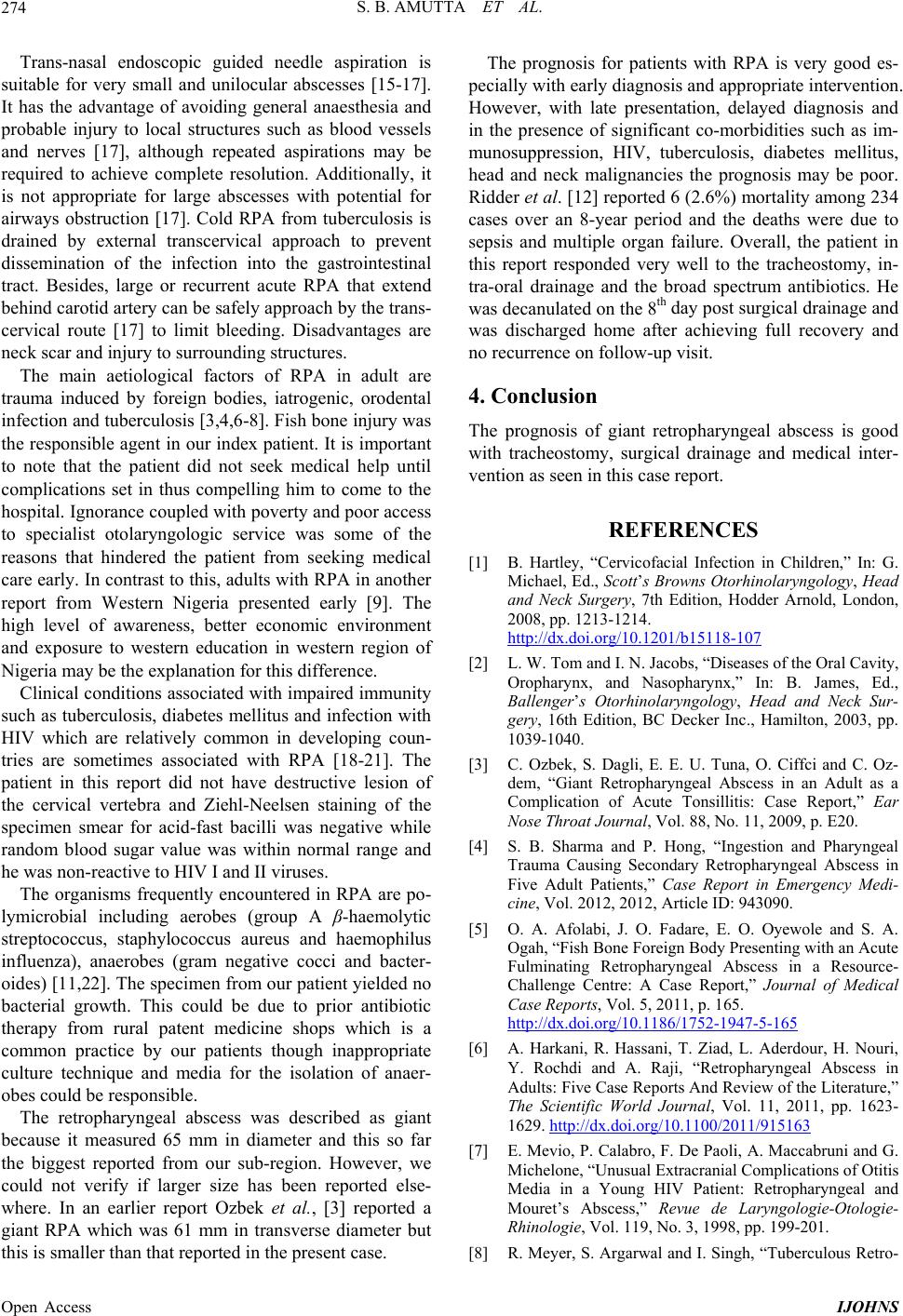
S. B. AMUTTA ET AL.
274
Trans-nasal endoscopic guided needle aspiration is
suitable for very small and unilocular abscesses [15-17].
It has the advantage of avoiding general anaesthesia and
probable injury to local structures such as blood vessels
and nerves [17], although repeated aspirations may be
required to achieve complete resolution. Additionally, it
is not appropriate for large abscesses with potential for
airways obstruction [17]. Cold RPA from tuberculosis is
drained by external transcervical approach to prevent
dissemination of the infection into the gastrointestinal
tract. Besides, large or recurrent acute RPA that extend
behind carotid artery can be safely approach by the trans-
cervical route [17] to limit bleeding. Disadvantages are
neck scar and injury to surrounding structures.
The main aetiological factors of RPA in adult are
trauma induced by foreign bodies, iatrogenic, orodental
infection and tuberculosis [3,4,6-8]. Fish bone injury was
the responsible agent in our index patient. It is important
to note that the patient did not seek medical help until
complications set in thus compelling him to come to the
hospital. Ignorance coupled with poverty and poor access
to specialist otolaryngologic service was some of the
reasons that hindered the patient from seeking medical
care early. In contrast to this, adults with RPA in another
report from Western Nigeria presented early [9]. The
high level of awareness, better economic environment
and exposure to western education in western region of
Nigeria may be the explanation for this difference.
Clinical conditions associated with impaired immunity
such as tuberculosis, diabetes mellitus and infection with
HIV which are relatively common in developing coun-
tries are sometimes associated with RPA [18-21]. The
patient in this report did not have destructive lesion of
the cervical vertebra and Ziehl-Neelsen staining of the
specimen smear for acid-fast bacilli was negative while
random blood sugar value was within normal range and
he was non-reactive to HIV I and II viruses.
The organisms frequently encountered in RPA are po-
lymicrobial including aerobes (group A β-haemolytic
streptococcus, staphylococcus aureus and haemophilus
influenza), anaerobes (gram negative cocci and bacter-
oides) [11,22]. The specimen from our patient yielded no
bacterial growth. This could be due to prior antibiotic
therapy from rural patent medicine shops which is a
common practice by our patients though inappropriate
culture technique and media for the isolation of anaer-
obes could be responsible.
The retropharyngeal abscess was described as giant
because it measured 65 mm in diameter and this so far
the biggest reported from our sub-region. However, we
could not verify if larger size has been reported else-
where. In an earlier report Ozbek et al., [3] reported a
giant RPA which was 61 mm in transverse diameter but
this is smaller than that reported in the present case.
The prognosis for patients with RPA is very good es-
pecially with early diagnosis and appropriate intervention.
However, with late presentation, delayed diagnosis and
in the presence of significant co-morbidities such as im-
munosuppression, HIV, tuberculosis, diabetes mellitus,
head and neck malignancies the prognosis may be poor.
Ridder et al. [12] reported 6 (2.6%) mortality among 234
cases over an 8-year period and the deaths were due to
sepsis and multiple organ failure. Overall, the patient in
this report responded very well to the tracheostomy, in-
tra-oral drainage and the broad spectrum antibiotics. He
was decanulated on the 8th day post surgical drainage and
was discharged home after achieving full recovery and
no recurrence on follow-up visit.
4. Conclusion
The prognosis of giant retropharyngeal abscess is good
with tracheostomy, surgical drainage and medical inter-
vention as seen in this case report.
REFERENCES
[1] B. Hartley, “Cervicofacial Infection in Children,” In: G.
Michael, Ed., Scott’s Browns Otorhinolaryngology, Head
and Neck Surgery, 7th Edition, Hodder Arnold, London,
2008, pp. 1213-1214.
http://dx.doi.org/10.1201/b15118-107
[2] L. W. Tom and I. N. Jacobs, “Diseases of the Oral Cavity,
Oropharynx, and Nasopharynx,” In: B. James, Ed.,
Ballenger’s Otorhinolaryngology, Head and Neck Sur-
gery, 16th Edition, BC Decker Inc., Hamilton, 2003, pp.
1039-1040.
[3] C. Ozbek, S. Dagli, E. E. U. Tuna, O. Ciffci and C. Oz-
dem, “Giant Retropharyngeal Abscess in an Adult as a
Complication of Acute Tonsillitis: Case Report,” Ear
Nose Throat Journal, Vol. 88, No. 11, 2009, p. E20.
[4] S. B. Sharma and P. Hong, “Ingestion and Pharyngeal
Trauma Causing Secondary Retropharyngeal Abscess in
Five Adult Patients,” Case Report in Emergency Medi-
cine, Vol. 2012, 2012, Article ID: 943090.
[5] O. A. Afolabi, J. O. Fadare, E. O. Oyewole and S. A.
Ogah, “Fish Bone Foreign Body Presenting with an Acute
Fulminating Retropharyngeal Abscess in a Resource-
Challenge Centre: A Case Report,” Journal of Medical
Case Reports, Vol. 5, 2011, p. 165.
http://dx.doi.org/10.1186/1752-1947-5-165
[6] A. Harkani, R. Hassani, T. Ziad, L. Aderdour, H. Nouri,
Y. Rochdi and A. Raji, “Retropharyngeal Abscess in
Adults: Five Case Reports And Review of the Literature,”
The Scientific World Journal, Vol. 11, 2011, pp. 1623-
1629. http://dx.doi.org/10.1100/2011/915163
[7] E. Mevio, P. Calabro, F. De Paoli, A. Maccabruni and G.
Michelone, “Unusual Extracranial Complications of Otitis
Media in a Young HIV Patient: Retropharyngeal and
Mouret’s Abscess,” Revue de Laryngologie-Otologie-
Rhinologie, Vol. 119, No. 3, 1998, pp. 199-201.
[8] R. Meyer, S. Argarwal and I. Singh, “Tuberculous Retro-
Open Access IJOHNS